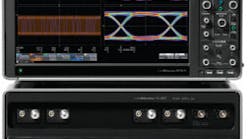Digital sampling oscilloscopes (DSOs) are among the most invaluable test instruments in any RF/microwave design laboratory. The latest test instruments from LeCroy Corp., the LabMaster 10 Zi oscilloscopes, employ silicon-germanium (SiGe) devices to achieve measurement bandwidths to 36 GHz at single-shot sampling rates to 80 GSamples/s on each channel, with measurement bandwidths up to 60 GHz and single-shot sampling rates to 160 GSamples/s when combining two DSO channels.
A LabMaster 10 Zi oscilloscope (see figure) consists of a Master Control Module (MCM) and 1 to 5 Acquisition Modules. The latter can be precisely synchronized to provide as many as 10 measurement channels each with 60 GHz bandwidth or 20 measurement channels each with 36 GHz bandwidth. The MCM is powered by an Intel Xeon X5660 2.8-GHz or better microprocessor. Each LabMaster central processing unit (CPU) contains two processors, each of which has six cores. Processors are backed by 24-Gb memory standard, with up to 192 Gb processor memory available as an option.
The MCM generates a single stable 10-GHz clock signal for synchronization of the acquisition modules and measurement channels. Input signals are measured via 50-Ω, 2.92-mm coaxial connectors; they are displayed with 8-b vertical resolution and with as much as 11-b vertical resolution. The 10%/90% rise time for the 60-GHz/36-GHz vertical measurement system is 7.5 ps; the 20%/80% rise time is 5.6 ps.
The LabMaster 10 Zi oscilloscopes boast active device cutoff frequency (fT in excess of 200 GHz). This advanced semiconductor process, which provides high-speed analog-to-digital converters (ADCs), combines with LeCroy's Digital Bandwidth Interleave (DBI) techniques and the LabMaster ChannelSync modular architecture to achieve outstanding performance and bandwidth density for multiple-channel measurements. The DBI approach serves to multiple the available bandwidths by splitting a wide-bandwidth signal into multiple signal paths of lower bandwidths, acquiring these lower-bandwidth signal components, and then reassembling the individual paths into a single wide-bandwidth path using advanced digital-signal-processing (DSP) techniques. This DBI technique makes it possible to provide oscilloscope bandwidth in excess of what is possible with just ADC chip bandwidth alone. For more information on the ChannelSync technology, Lecroy offers a free white paper for download.
LabMaster's horizontal measurement system provides time/division scales of 10 ps/div to 64 s/div for measurements through 36 GHz and 10 ps/div through 640 s/div for signals at higher frequencies than 36 GHz, depending upon memory length. Instruments can be supplied with 512 Mpoints/channel maximum analysis memory. Typical jitter noise floor for any acquisition time length is 100 fs root mean square (RMS).
The LabMaster 10 Zi oscilloscopes show captured signals on a built-in 15.3-in. display with 2560 x 1600 pixels resolution. Measurement capabilities are supported by an extensive range of standard math tools (included), and many software options are available.
Finally, these new models are backwards compatible with the company's earlier 9 Zi A oscilloscopes. P&A: $252,900 and up (LabMaster 10 Zi oscilloscopes) and $156,000 and up (acquisition modules).
LeCroy Corp., 700 Chestnut Ridge Rd., Chestnut Ridge, NY 10977-6435; (800) 553-2769, (845) 425-2000, www.lecroy.com.

